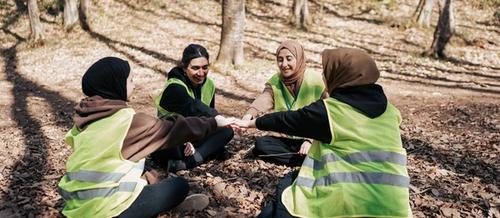
Reignite the spark in the work you love - without losing yourself.
Connection, nourishment and practical learning for teams, workplaces and community groups.

Safety is a verb.
What do you see in the image above?
At first glance, it’s simple: a climber scaling a vertical rockface.
But look again through a safety lens, and you’ll notice something else: the ropes, harnesses, the anchor points, the bag of chalk (used to absorb sweat and moisture, increase friction and provide a more secure grip), the helmet, the look on the climber's face...
You can feel the preparation involved and the continual assessment of safety.
It's not a 'one and done' situation, but an ongoing process.
This is safety in action - a dynamic and active assessment of risk.
The concept of creating 'safe spaces' has become a popular way of indicating one's best intentions for those attending an event or experience.
The Oxford Learner's Dictionary defines a 'safe space' as "a place in which a person or a particular group of people can know that they will be free from harm or criticism".
In reality however, we never know if an experience is going to feel 'safe', because safety is unique to each person, relationship and situation.
Of course people need to feel seen, heard, supported and as safe as possible.
But simply naming a group or session as a 'safe space' doesn’t make it so.
In fact, the language can be misleading, and at times even harmful.
Here’s why:
For example, experiences of feeling safe can be very different for someone facilitating a group versus someone who is accessing the group; or someone who is the newest, youngest or most vulnerable person present - what feels safe for me, may not feel safe for you, and vice versa.
The reality is that we can’t just declare “this is a safe space” and expect everyone’s experience to fall in line.
Safety isn’t a magic word.
It’s experiential.
It's environmental, relational, physiological, contextual, and always shifting.
It’s also why we no longer talk about safe spaces in supervision groups, workshops, or therapy sessions here at Tempo.
To summarise:
Compassion-focused therapy research shows that safeness activates our soothing system, the part of us that allows calm, curiosity, and courage. It’s not just the absence of threat; it’s the presence of connection.
Brené Brown offers some help through her conceptualisation of her acronym BRAVING, which unpacks the small, everyday practices that build trust.
This is what allows us to move from safety into safeness.
Here’s what BRAVING stands for:
Together, these seven elements remind us that trust isn’t abstract, it’s something we practice in relationship.
And when trust is present, safeness can grow.
Moving from safety to safeness isn’t a one-off event, it’s a practice.
It’s built through trust, through the everyday choices captured in BRAVING, and through the courage to keep showing up with openness and compassion.
So perhaps instead of promising safe spaces, we can commit to cultivating safeness - moment by moment, in relationship, together.
Safety is how you regulate the degree to which our threat system has been stimulated, whereas safeness is the degree to which you're able to explore.

Reignite the spark in the work you love - without losing yourself.
Connection, nourishment and practical learning for teams, workplaces and community groups.

Conceptualising a practice of collective care in health work.
Connection, community and collaboration are essential for best outcomes in healthcare work. Drawing inspiration from thought leaders and research that advocates for a collective, compassionate and courageous response to peer support, this blog conceptualises a unique approach to collective care. How can we develop and support each other through creative expression and networks that hold us with a strong back, soft front, wild heart and clear mind for the wellbeing of our clients and our own sustainability in the work?

For too long there has been a focus on self care when we work in systems with groups of people, in community. We know that community, authentic connection and support are essential for our survival: the pandemic taught us just how vital we are for each other, and polyvagal theory confirms that the need to come together for safety and support is built into our neurobiology. So what is collective care? What does it mean? Why is it so important? Take a look below to find out more.

Creative embodied group supervision for therapists, clinicians and service providers
Join a small group of peers to learn, explore, connect, express and reflect through shared discussion, music and creative arts experiences.